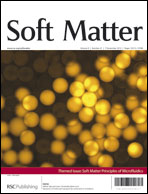Interface-induced recirculation within a stationary microfluidic drop†
Abstract
We study the flow within a stationary drop in a Hele-Shaw cell. The experiments are performed in a microfluidic channel, whose surface is patterned with a single hole that serves to anchor the drop while the outer fluid continues to flow. The recirculation pattern is found to be localized near the liquid–liquid interface for all conditions, with most of the fluid motion taking place in the curved rim of the droplet. In contrast, the drop's central region remains nearly stationary. This flow pattern corresponds to a three-dimensional recirculation on the drop surface, with the fluid moving in the direction of the outer flow on the central plane and in the opposite direction closer to the boundaries. The different velocities scale linearly with the outer fluid velocity for all geometries studied. However, the velocity on the interface is found to be lower than the driving velocity even in the case of a gas bubble, pointing to the effect of surface stresses as the underlying retardation and recirculation mechanism. This motivates the development of a Marangoni model to account for the

- This article is part of the themed collection: Soft matter principles of microfluidics.

 Please wait while we load your content...
Please wait while we load your content...